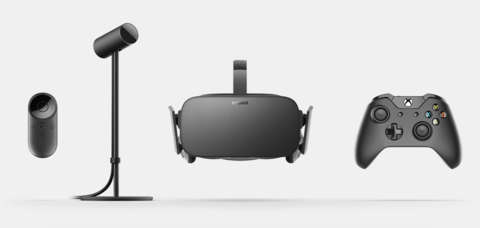Update: Click here to check out our review of the Oculus Touch controllers.
Virtual reality isn't a recent invention, but thanks to the efforts of Oculus, it's more viable than ever. Over the past four years, Oculus has developed and demoed numerous prototypes of its Rift headset, adding features and refining designs at a rapid pace. It wasn't long before VR, and Rift specifically, became the talk of conventions like CES and GDC.
With the likes of HTC and Sony stepping up to the plate with their own VR headsets, and major developers creating games specifically for these devices, it's undeniable: the industry is finally ready to support VR. But for as much momentum as Rift and its competitors have, the general public is still on the fence. At $600, Rift is expensive relative to consoles like PS4 and Xbox One, and when you add the cost of an appropriately-powered PC, VR as a whole is almost prohibitively-priced for the majority of gamers. After spending a week using Rift, however, I can look past the price tag and see it for what it is: a key to a new era of entertainment. It lets you to engage with games in ways that haven't been possible before, instilling a tangible sense of presence that's immediately exciting.
However, the transition into VR isn't seamless. When you first put on a Rift, you are all too aware of the headset. It's somewhat comfortable, but the way it envelopes your head can make it feel like a helmet. When you're using it, the lenses tend to blur images on the edge of the display--which, at 1080p, appears slightly low-res--and you can see a bit of light sneaking in from the bottom of the headset. Though I was painfully aware of these issues at first, Rift's presentation and handling of VR content ultimately distracted me from these initial annoyances.
Rift and its accompanying accessories feel like premium products. The headset's chassis is wrapped in a pleasing, fabric-like material that makes it feel like a luxury item. All three of its straps have a velcro solution for adjustments, and they converge at the back with a sturdy, triangular brace that cups the back of your head. The inside of the headset--the part that makes contact with your face--is lined with contoured foam, and an added layer of felt-like material.

The built-in headphones are unusual in that they are attached directly to the headset's straps, but they are on rotatable, hinged rails that allow for easy adjustments on-the-fly. The actual headphone portion of the setup is an on-ear configuration with plenty of padding, wrapped in a soft mesh fabric. All told, the headset has a sturdy and intuitive design, with materials that feel in-line with its $600 price tag--nothing about it feels cheap or compromised. While it's hard to completely forget you're wearing it, Rift never feels like a burden when you're mentally invested in a VR experience.
Everyone reacts to VR in different ways, but because Rift's sensor tracks six degrees of movement and its display has a high refresh rate and low pixel persistence, hardware issues that could inadvertently distort your sense of orientation are accounted for out of the gate, making it easy to feel immersed in your game of choice.
That said, games can still play with your senses in undesirable ways that Rift can't account for on its own. Adr1ft, for example, is a game about floating through a broken space station. Your body twists and turns with simulated weightlessness. It's not entirely unlike EVE Valkyrie in that sense, where you pilot a ship that can rapidly flip and rotate. Regardless, Adr1ft made me so uncomfortable in VR that I had to stop playing it--despite the fact that there's a feature in the game designed to combat such issues--whereas I was completely fine in EVE Valkyrie. It's a product of how good Rift is at convincing your brain that what you're seeing is "real" and evidence of the fact that software is an equally important part of the equation.

Oculus Home identifies three levels of intensity for all games: comfortable, moderate, or intense. It's a helpful grading system, but it's also a reminder that for all of the wonderful opportunities VR presents, it will be challenging to use for people who are susceptible to motion sickness. I wouldn't normally count myself as part of that group, and thankfully, I only felt uneasy in that one instance.
Rift is for more than just games, however, and some of the most enchanting--and least intense--VR experiences are passive. There are 360-degree videos taken from locales around the globe available in Oculus Home, as well as 3D rendered short films that transport you to otherworldly places, sometimes just for the sake of being there. While the quality of some of these videos falls short when compared to the selection of games, they offer a tantalizing taste of what virtual tourism and storytelling will be like once VR gains more traction outside of video games.
In order to get a smooth and enjoyable experience with Rift, you need a better-than-average gaming PC. The requirements aren't outrageous, and some people may only need to upgrade one or two components in their existing PC to get started. But to build or purchase a Rift-ready system will cost--at a minimum--close to $1,000, raising the entry fee considerably for some customers.

Oculus Rift Minimum Requirements
- Graphics Card: GeForce GTX 970 or AMD Radeon R9 290 or better.
- CPU: Intel Core i5 4590 or greater.
- RAM: 8GB or more.
- Video port: HDMI 1.3.
- USB port: 2 USB 3.0 ports.
- Operating system: Windows 7 SP1 or newer.
Presuming you have a capable enough PC, setting up Rift is a simple affair. After installing the Oculus software on your PC, you are guided, step-by-step, with clear and simple directions. Essentially, you're told to plug a specific device in, the software confirms that it's connected, and you move on to the next piece of the kit.
The fact that there's so little to say here is a good thing, but it's worth noting that we ran into one issue with our Rift that forced us to reach out to our contact at Oculus. Seemingly out of nowhere, Oculus' software reported it couldn't detect Rift's HDMI cable. While there is a support website for Rift, the solution we needed wasn't on it. After contacting Oculus, we were instructed to pop the foam lining off of the inside of the headset to access Rift's cable connection. After disconnecting and then reseating the cable, our issue was resolved. Oculus told us that this would be added to its support documentation by this week.
Oculus has its own platform for distributing games, apps, and other VR content called Oculus Home. It can be used within the headset, or as a traditional desktop PC app. In VR, your gaze directs an on-screen cursor, and you click icons with the A button on the Xbox One controller, or with the included Oculus' remote. The store is mildly ambiguous at first, but once you begin to look around at various icons, navigating it becomes second nature.

Beyond a means of purchasing and accessing VR content, Oculus Home is also where you can see if your friends in the Oculus network are online and what they're up to. Unfortunately, there's no way to invite friends into games from Oculus Home at launch.
Pressing the home button on the included Xbox One controller during a game will take you to a menu within Oculus Home where you can reorient the headset's positional tracking--a quick, two-step process--adjust the volume of the headphones, check the time, or view notifications from Oculus or your friends.
Oculus has prepared a wide array of games and passive experiences for launch, and everyone who has pre-ordered a Rift gets two games for free. One is a Lucky's Tale, a 3D platformer set in an adorable cartoon landscape that borrows heavily from games like Super Mario 64. The other is EVE Valkyrie, an aerial combat simulator set in outer space. With racing, sports, adventure, horror, strategy, and puzzle games--to name some of the genres represented in the launch lineup--there are plenty of ways to explore the potential VR introduces to video games.
I can look past the price tag and see Rift for what it is: a key to a new era of entertainment.
The best part of the launch lineup is that most of the games are full products, not tech demos. Up until this point, we could only sample Rift's capabilities via brief demos, which had some people concerned that VR games wouldn't be able to compete with traditional console or PC games. Thankfully, this isn't the case. Rift owners will have access to numerous, fully-realized games at launch, and even though some of them are ports of games that originated outside of the scope of VR--including Project C.A.R.S. and AirMech--they still benefit from Rift's capabilities, either by introducing new modes or by allowing you to experience them in a more personal, intimate way than before.
Of course, not every VR game is a good game by default. EVE Valkyrie, for example, is littered with microtransactions that detract from its initial appeal. Lucky's Tale, while charming and fun, pads out its levels by forcing you to replay them with alternate objectives. After five hours battling my way through an enigmatic dungeon, Chronos is--so far--an amazing game that recalls favorites like Resident Evil, The Legend of Zelda, and Dark Souls. However, it stumbles on occasion due to a handful of design flaws, including the unforgiving way that it allows you to walk into pitfalls, some of which are difficult to see due to Chronos' use of fixed camera perspectives.

Clearly, VR games are susceptible the same problems as regular games, but there's something about the unique, VR experience that makes up the difference--at least a little bit. When I'm flying around in EVE Valkyrie, immersed in my virtual cockpit, soaring through space debris, I'm entranced by how convincing it feels. When I lean in to get a closer look at Lucky the fox, I feel a connection, however contrived, when he looks up and greets me with a wave and a smile. Likewise, when I guide him through a narrow tunnel, I can sense space shrink around me. When you're playing a game on a monitor, the real world is in equal view. When that is stripped away and filled in with the world of the game you're playing in VR, it's a very powerful experience that traditional gaming platforms simply don't offer.
VR is a very powerful experience that traditional gaming platforms simply don't offer.
Were Rift more uncomfortable to wear, or less technically capable of displaying frames quickly with low latency, then I wouldn't feel comfortable recommending it. If it wasn't easy to setup and configure, I would think twice before claiming it's ready for market. But these concerns were quickly dashed. I had Rift up and running in a matter of minutes. I played game after game that opened my eyes to the possibilities that VR and headsets like Rift make possible.
$600 is a lot to pay for a piece of gaming hardware. But Rift is different from a console or a new graphics card. Rift allows you to experience games in ways that we've only dreamed of up until now, and while it requires you to make a few compromises in the name of immersion, it's worth it. Yes, you will look silly to anyone who watches you use it, and you will potentially feel uneasy after an intense VR session, but these issues can't take away from the fact that Rift delivers on its promise to enable more immersive and personal gaming experiences than we've ever seen before.

